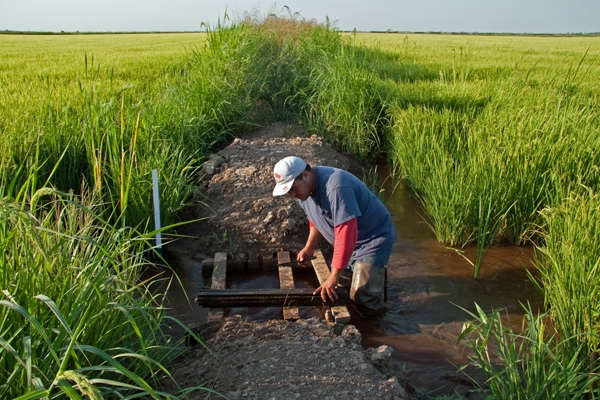Driving this week, I saw quite a few fields with heads starting to show up so drain time is around the corner. Earlier than normal planting and a warm early season means that the crop is going to be harvested earlier than normal. Soon growers are going to begin making the decision as to when to drain the field in preparation for harvest. Cass Mutters is the only one I am aware of that has done research on this and he suggested you could drain safely 21-24 days after heading. A few thoughts on this.
I think most growers are a bit reluctant to drain this early, given the risk of lower quality if soil dries out too quickly.
- Drain time will be soil dependent. Some soils dry out faster than others.
- This year with a lot of fallow fields and pump usage, the “typical” hydrology of fields is different. Pumps can lower ground water tables in their near vicinity, perhaps causing water to percolate more readily downward and the soils dry up faster. Also rice fields adjacent to fallow fields may lose water faster due to lateral water movement towards dry fields.
- If the weather is really warm and dry (especially with north winds), growers may want to hold water a bit longer as well due to increased ET.
All that said, growers could save water by stopping irrigation early and allowing water to naturally subside. This is as opposed to applying irrigation water until you are ready to pull the boards at the end of the season. As a rule of thumb, ET losses are about ¼ inch a day. So, if you have 4 inches of water in your field, that would keep the field flooded or saturated for about 16 days. Given that water may drop faster this year (due to reasons mentioned above), it may be safer to plan for about ½ inch loss a day. So, let use an example of a grower who typically pulls the boards at 25 days after heading and expects the surface water to be drained from the field by 28 days. If this grower has 5 inches of water in the field, this water would last about 10 days. Therefore, irrigation water could be halted at 18 days after heading; and by 28 days, the field water would be similar as if they pulled the boards at 25 days. This would save one week of irrigation water.
Obviously, how fast water drops in a field once the water has been turned off is soil, year and location dependent. As we go into the future, where water limitations may become more frequent, it would be a good idea for growers to track how fast water drops in a field when boards are in place and no irrigation water is coming in. All you need is a stake in the field with 1” markers and simply record how much the water lowers each day. Keep in mind that in fields with a slope, the upper checks may drain into lower checks, so the stake should be in the upper check which will dry out the fastest. When doing this, make note of if adjacent fields are flooded or not or if a well is close by. Keeping records for a few years, will help farmers make more informed decisions in future years.
Photo: Jim Morris, CRC
